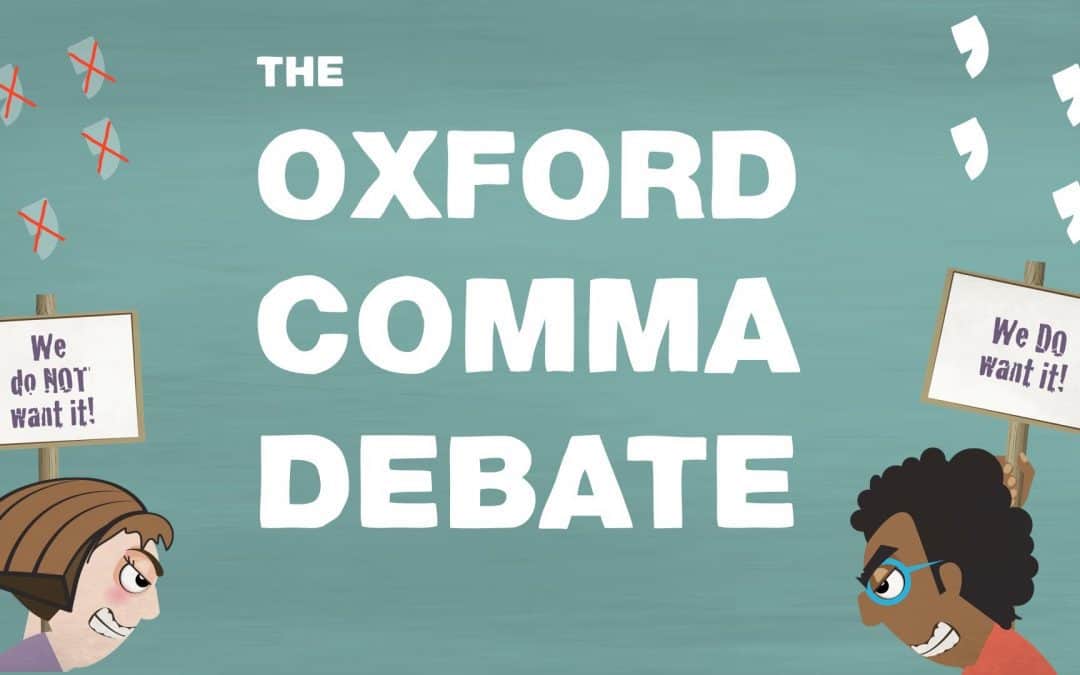The Oxford Comma: What Is It, and Should You Use It?
Among people passionate about grammar, whether they be writers, editors, teachers, or students, there’s been an ongoing debate for some now. The point of contention? The Oxford comma, also known as the serial comma or the Harvard comma. Not everyone knows just what an Oxford comma is, however, let alone how to use one, or whether they should use one in the first place. This article aims to educate you on what the Oxford comma is, what the current attitudes toward the Oxford comma are, and whether or not you should use one in your own writing.
The Oxford Comma: Usage
When constructing a list of items, it’s customary to use commas to separate the items in the list. But should you put a comma before the final item? Consider these two examples:
I went to the store and bought apples, bananas and oranges.
I went to the store and bought apples, bananas, and oranges.
Can you spot the difference? See the comma after “bananas” in the second example? That’s the Oxford comma.
Which of these versions of this sentence is correct? It’s not such an easy question. Some claim that ONLY the first version is correct, while others claim that ONLY the second version is correct. Others, however, view either option as acceptable.
Where Do the Style Guides Stand?
“Style guides” are official documents put out by organizations dictating the rules and conventions of grammar that they expect writers working under their umbrella to follow. Most major style guides MANDATE (require) the use of the Oxford comma, including the APA Style Guide, the Chicago Manual of Style, the MLA style guide, and Strunk and White’s classic grammar text, The Elements of Style.
Other style guides, however, advise against using the Oxford comma. Most of the style guides that don’t require the Oxford comma are journalistic style guides, and it’s likely they advise against using it because it saves space. The New York Times style guide and the AP style guide are examples of this attitude.
What Are the Arguments For and Against the Oxford Comma?
Proponents of the use of the Oxford comma argue that it’s critical to employ for a variety of reasons.
People who advocate the Oxford comma say that it’s conventionally been standard practice. They also note that the Oxford comma indicates a slight pause that mimics the slight pause one would make when speaking the sentence aloud. Most importantly, they argue that using (or not using) the Oxford comma eliminates potential AMBIGUITY in sentences, such as the following example:
I’d like to thank my parents, God and Sally.
I’d like to thank my parents, God, and Sally.
Notice that in the first example, the writer is suggesting (perhaps unintentionally) that his or her parents ARE God and Sally. In the second example, the use of the Oxford comma eliminates this unintential ambiguity. The second example clearly establishes that the writer would like to thank the three items in the list separately.
Advocates for the Oxford comma also claim that its absence establishes a stronger association between the last two items in a list than may naturally exist between them.
Opponents of the Oxford comma ALSO claim that the lack of an Oxford comma is consistent with how English has been conventionally written. They also consider the use of the Oxford comma redundant, maintaining that the “and” is good enough separation between the final two terms in a list. Opponents also charge the Oxford comma with creating ambiguity, as in the following example:
To my parents, God, and Sally.
Opponents of the Oxford comma say that the commas surrounding the word “God” in the list above make the word “God” into an appositive phrase, implying unintentionally that the writer’s parents ARE God.
Examining the two potential situations of ambiguity, most people might concluce that the first ambiguity is more obvious, and as a result, the Oxford comma should be used.
Should You Use the Oxford Comma?
The question of whether or not you should use the Oxford comma depends on who you’re writing for. If you’re supposed to be following a specific style guide, then follow that style guide. In your personal writing, do whatever you want.
I personally use the Oxford comma and have always done so, because I believe the ambiguity created by the lack of an Oxford comma is more detrimental than the ambiguity that adding an Oxford comma might introduce.
Do the ACT and SAT Test Usage of the Oxford Comma?
Breathe easily, high school students. You will never be forced to choose between a sentence with an Oxford comma and a sentence without one. Some passages on the SAT and ACT might employ the Oxford comma, while others won’t. Though the SAT and ACT test you on a ton of rules and conventions of grammar, they don’t take a stance on the Oxford comma. An Oxford comma alone (or the lack thereof) won’t make a choice right or wrong. Choices will be correct or incorrect for other reasons.
* * *
That’s it! For more SAT and ACT prep tips, check out the rest of our blog. Looking for 1-on-1 ACT or SAT prep tutoring? Want to join an SAT or ACT group class? Contact us today!
